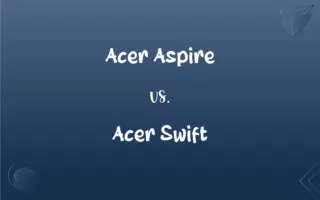Meissner Corpuscles vs. Pacinian Corpuscles: What's the Difference?
Edited by Harlon Moss || By Janet White || Published on February 5, 2024
Meissner's corpuscles are sensitive to light touch and located in the skin's upper layers, whereas Pacinian corpuscles respond to deep pressure and vibration in deeper tissues.

Key Differences
Meissner's corpuscles, found in the upper layers of the skin, are specialized for detecting light, fine touch, and texture. Pacinian corpuscles, located deeper in the dermis and in other tissues, are adapted to sense deep pressure and vibration, responding to more substantial physical stimuli.
Meissner's corpuscles play a crucial role in tactile acuity, particularly in fingertips, allowing for detailed perception of objects' surfaces. Pacinian corpuscles are essential for perceiving vibrations and deep pressure, providing feedback about objects' movements and forces applied to the skin.
The structure of Meissner's corpuscles is designed for rapid adaptation to stimuli, making them highly sensitive to changes in touch but not prolonged pressure. In contrast, Pacinian corpuscles have a layered, onion-like structure, allowing them to adapt to sustained pressure and detect high-frequency vibrations.
Meissner's corpuscles contribute significantly to tasks requiring fine motor skills and detailed tactile discrimination, such as reading Braille. Pacinian corpuscles are vital in perceiving surface textures through transmitted vibrations, like feeling the roughness of a road through a vehicle's steering wheel.
Meissner's corpuscles have a lower threshold for activation, responding to lighter stimuli, while Pacinian corpuscles require more substantial mechanical deformation for activation, reflecting their roles in sensing different types of tactile information.
ADVERTISEMENT
Comparison Chart
Location
Upper skin layers
Deep in the dermis and other tissues
Sensitivity
Light touch, fine details
Deep pressure, vibration
Adaptation
Rapid adaptation to changes in touch
Adapt to sustained pressure, high-frequency vibrations
Role in Tactile Sense
Fine motor skills, detailed tactile discrimination
Perceiving vibrations, detecting surface textures
Activation Threshold
Low, responsive to lighter stimuli
Higher, requires substantial mechanical deformation
ADVERTISEMENT
Meissner Corpuscles and Pacinian Corpuscles Definitions
Meissner Corpuscles
Sensory receptors in the skin sensitive to light touch.
The Meissner's corpuscles in her fingertips helped her feel the fine texture of silk.
Pacinian Corpuscles
Adapt to sustained pressure and high-frequency vibrations.
The Pacinian corpuscles helped her sense the rumbling of the approaching train.
Meissner Corpuscles
Nerve endings in the dermal papillae crucial for tactile acuity.
Braille is readable due to the sensitivity of Meissner's corpuscles.
Pacinian Corpuscles
Encapsulated nerve endings sensitive to mechanical stimuli.
The massage pressed deeply enough to stimulate his Pacinian corpuscles.
Meissner Corpuscles
Rapidly adapting mechanoreceptors in the upper dermis.
Meissner's corpuscles react quickly to changes in surface contours.
Pacinian Corpuscles
Onion-like structure enabling detection of deep tactile sensations.
His Pacinian corpuscles responded to the deep tissue massage.
Meissner Corpuscles
Specialized for fine touch and pressure sensation.
The artist's Meissner's corpuscles discerned the subtle differences in paint textures.
Pacinian Corpuscles
Located in deeper skin layers, ligaments, and joints.
Pacinian corpuscles in the joints contribute to proprioception.
Meissner Corpuscles
Concentrated in areas requiring precise tactile feedback.
The high concentration of Meissner's corpuscles in her fingertips aided in delicate surgical procedures.
Pacinian Corpuscles
Deep pressure and vibration receptors in the skin and other tissues.
Pacinian corpuscles in his hands detected the engine's vibrations.
FAQs
Are Pacinian corpuscles sensitive to light touch?
No, they respond to deeper pressure.
Where are Meissner's corpuscles located?
In the upper layers of the skin, especially fingertips.
What is the role of Meissner's corpuscles in touch?
They are crucial for fine tactile discrimination.
What do Pacinian corpuscles detect?
Deep pressure and vibrations.
How do Meissner's corpuscles adapt to stimuli?
They rapidly adapt to changes in touch.
What activities rely on Meissner's corpuscles?
Activities requiring fine motor skills, like writing or surgery.
Do Meissner's corpuscles contribute to proprioception?
They are more involved in surface touch perception.
Do Pacinian corpuscles have a low activation threshold?
No, they require more substantial stimuli.
Do Pacinian corpuscles adapt quickly to stimuli?
They adapt to sustained pressure and high-frequency vibrations.
How do Pacinian corpuscles respond to vibrations?
They are sensitive to high-frequency vibrations.
Can Meissner's corpuscles detect vibrations?
They are more sensitive to light touch than vibrations.
Are Meissner's corpuscles present in all skin areas?
No, they are concentrated in areas requiring high tactile acuity.
Can Pacinian corpuscles detect light touch?
They are better suited for sensing deep pressure.
Are Meissner's corpuscles active during prolonged pressure?
They rapidly adapt and are less responsive to sustained pressure.
Do Meissner's corpuscles respond to deep pressure?
They are more sensitive to light, fine touch.
Where else, besides the skin, are Pacinian corpuscles found?
In deeper tissues, ligaments, and joints.
What makes Pacinian corpuscles unique in structure?
Their onion-like, layered structure.
What type of touch do Meissner's corpuscles primarily detect?
Light, fine touch and texture.
Are Pacinian corpuscles found in the upper skin layers?
No, they are located deeper in the dermis and other tissues.
What is the role of Pacinian corpuscles in the sensory system?
They provide feedback about deep pressure and vibrations.
About Author
Written by
Janet WhiteJanet White has been an esteemed writer and blogger for Difference Wiki. Holding a Master's degree in Science and Medical Journalism from the prestigious Boston University, she has consistently demonstrated her expertise and passion for her field. When she's not immersed in her work, Janet relishes her time exercising, delving into a good book, and cherishing moments with friends and family.
Edited by
Harlon MossHarlon is a seasoned quality moderator and accomplished content writer for Difference Wiki. An alumnus of the prestigious University of California, he earned his degree in Computer Science. Leveraging his academic background, Harlon brings a meticulous and informed perspective to his work, ensuring content accuracy and excellence.






































































